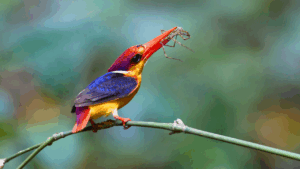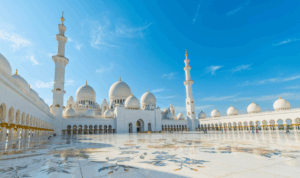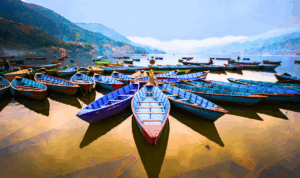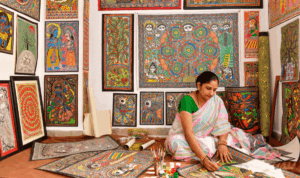Festivals are more than dates on a calendar — they are expressions of belief, community, and continuity.
In Sri Lanka, Nepal, Bhutan, and the UAE, celebrations move through streets, courtyards, and kitchens, connecting past and present through rhythm, ritual, and food. Each festival has its own sound, scent, and texture — offering travelers an authentic glimpse into a culture that lives through its traditions.
Sri Lanka
Kandy Esala Perahera (July–August) 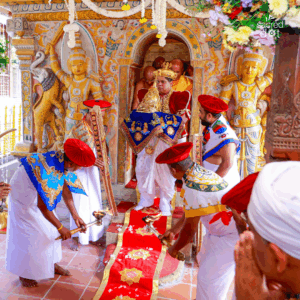
Each year, the hill capital of Kandy transforms into a city of sound and movement during the Esala Perahera. The festival honours the Sacred Tooth Relic of the Buddha, enshrined in the Temple of the Tooth, and is one of Asia’s oldest living Buddhist rituals.
As dusk falls, the streets fill with the rhythm of davula drums and the scent of burning coconut torches. Dancers in silver breastplates and ankle bells perform to the beat of cymbals, while elephants draped in embroidered silk carry temple relics beneath canopies of gold and crimson. The procession grows each night, culminating in the grand Randoli Perahera, led by the casket bearing the Tooth Relic’s replica. It concludes with the water-cutting ceremony (Diya Kepeema) at the Mahaweli River, symbolizing purity and renewal.
Festival Delicacy: Kiribath (milk rice) — cooked in coconut milk and cut into diamond-shaped pieces — is shared during the Perahera as a sign of prosperity.
Sinhala & Tamil New Year (April) 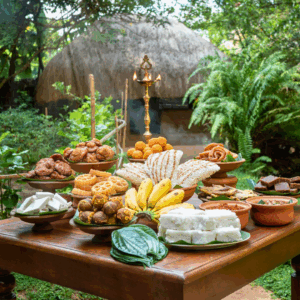
In April, Sri Lanka celebrates Avurudu, the Sinhala and Tamil New Year, marking the sun’s transition from Pisces to Aries and the start of a new agricultural cycle. The day begins with rituals guided by astrology — lighting the hearth at an auspicious time, taking the first meal, and exchanging oil anointing blessings.
Homes are filled with the aroma of sweet and savoury treats. Families fry kokis, delicate rice flour crisps shaped with iron moulds, alongside aluwa and mung kavum. Children play traditional games in courtyards, and neighbours exchange plates of food in a gesture of goodwill.
Festival Delicacy: Kokis — delicate, flower-shaped crisps made from rice flour and coconut milk — are fried to a pale golden colour and kept in tins for guests and neighbours who visit during the New Year. Their light crunch and subtle sweetness make them one of the most familiar tastes of Avurudu, symbolising hospitality and abundance shared across every Sri Lankan home.
Nepal
Dashain (September–October) 
Dashain, Nepal’s grandest and longest festival, celebrates the triumph of good over evil and the victory of goddess Durga over the demon Mahishasura. Spanning fifteen days, it unites families across the country. People return to their ancestral homes, clean and decorate their spaces, and offer prayers for prosperity and protection.
Temples fill with devotees, kites flutter in autumn skies, and bamboo swings are set up in villages for children and adults alike. Homes are adorned with marigold garlands, and elders bless the younger ones. They put a tika (a mixture of rice, yogurt, and vermilion) on the foreheads of young one and use jamara (sacred barley shoots) to ward of evil.
The festival embodies the warmth of reunion — generations gathering over shared meals, music, and laughter. For Nepalis abroad, Dashain evokes a deep sense of nostalgia, connecting them to home through ritual and remembrance.
Festival Delicacy: Khasi ko masu (goat curry) is the centerpiece of Dashain feasts. Tender pieces of goat meat are slow-cooked with aromatic spices, garlic, ginger, and tomatoes. It is served alongside rice, lentils, and seasonal vegetables. Rich, hearty, and deeply comforting, it’s a dish that captures the spirit of togetherness that defines Dashain.
Holi (March) 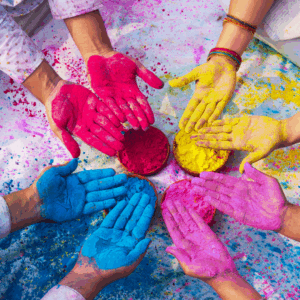
Holi, the festival of colours, marks the arrival of spring. In Kathmandu’s Durbar Square, the night before Holi begins with the lighting of the Chir bonfire, symbolizing the victory of good over evil. The next morning, streets turn into a mosaic of colour as people throw powdered pigments and water balloons, sing folk songs, and share sweets.
In the Terai region, the celebration extends over two days, featuring local music and community dances.
Festival Delicacy: Sel roti — ring-shaped bread made from fermented rice flour, sugar, and cardamom — is prepared in homes across Nepal during Holi and other major festivals. The batter is poured skillfully by hand into hot oil, forming perfect circular loops that puff and turn golden brown. Crisp on the outside and soft within, sel roti carries a mild sweetness and aroma of ghee. It is often served warm with yoghurt, pickles, or potato curry, and shared with friends, neighbours, and guests who visit during the celebrations.
Bhutan
Paro Tsechu (March–April) 
The Paro Tsechu is Bhutan’s most famous festival, dedicated to Guru Rinpoche, who introduced Buddhism to the country in the 8th century. Over several days, the courtyards of Paro Dzong fill with locals and monks dressed in vibrant robes and masks, performing cham dances that recount spiritual legends and moral teachings.
The final morning is marked by the unfurling of a giant religious scroll painting, the thongdrol, believed to bestow blessings simply by sight. The festival blends devotion, community gathering, and quiet reflection amid the sound of long horns and ritual chants echoing through the valley.
Festival Delicacy: Ema datshi — a stew made with Bhutan’s local chillies and soft farmer’s cheese — is considered the national dish and a staple during festivals like Paro Tsechu. Fresh green and red chillies are sliced and simmered with onions, garlic, and local cheese until the sauce thickens into a creamy, spicy base. The result is a dish that is both fiery and comforting, often eaten with Bhutanese red rice and accompanied by seasonal vegetables. Its heat reflects the country’s high-altitude climate, while its simplicity embodies Bhutanese cooking — wholesome, local, and deeply tied to the rhythms of everyday life. During Tsechu, families prepare large pots of ema datshi to share with guests, monks, and neighbours, reinforcing the sense of community that defines the festival.
Thimphu Tshechu (September) 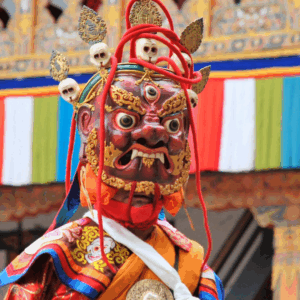
Held in the capital city, the Thimphu Tshechu is a national event that combines religious observance with social celebration. Monks and lay dancers perform sacred masked dances in the courtyard of Tashichho Dzong, while families dressed in formal gho and kira gather to watch, socialize, and receive blessings.
Markets spring up around the dzong, selling textiles, local snacks, and incense. The festival represents Bhutan’s ideal of balance between spirituality and everyday life.
Festival Delicacy: Hoentay — buckwheat dumplings filled with spinach, turnip leaves, or cheese — are a traditional dish from Bhutan’s Haa Valley, often prepared during the Thimphu Tshechu. The dough, made from locally grown buckwheat, is rolled thin and wrapped around the savoury filling before being steamed or lightly fried. The dumplings are served with chilli paste or butter tea, combining earthy, nutty flavours with a hint of spice. Because buckwheat thrives in Bhutan’s high-altitude valleys, hoentay reflects the region’s agrarian roots and the self-sufficiency of rural communities. During Tshechu, families make large batches to share with relatives and guests, turning a simple mountain meal into a gesture of generosity and celebration.
United Arab Emirates
Eid al-Fitr (Dates vary) 
In the UAE, Eid al-Fitr marks the end of Ramadan, a month of fasting and reflection. The day begins with communal prayers, followed by visits to relatives and neighbours. Streets are decorated with lights, and the sound of greetings — Eid Mubarak — fills the air.
Traditional dishes are prepared in every Emirati home. Families cook harees, made from wheat and meat slow-cooked to a soft, porridge-like texture, and serve it alongside dates, coffee, and sweets for visitors. The atmosphere is one of gratitude, charity, and renewal.
Festival Delicacy: Harees — a traditional Emirati dish of wheat and meat slow-cooked to a smooth, porridge-like texture — holds a central place in Eid al-Fitr celebrations across the UAE. Whole wheat is soaked overnight, simmered with lamb or chicken, and stirred for hours until the grains break down completely. The mixture is then enriched with ghee and a touch of cinnamon, giving it a warm, comforting flavour. The dish is served in large communal bowls, often shared with neighbours and guests after morning prayers. In many Emirati households, harees is among the first dishes prepared at dawn on Eid.
UAE National Day (December 2) 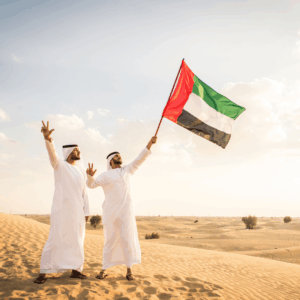
National Day commemorates the union of the seven Emirates in 1971. Cities celebrate with fireworks, air shows, and public performances that showcase both Emirati heritage and modern identity. Heritage villages in Abu Dhabi and Dubai organize craft demonstrations, camel shows, and traditional dances such as Al Ayala.
Street vendors and cafes serve local snacks and desserts. Among the most popular is luqaimat, small fried dough balls coated in date syrup and sprinkled with sesame — simple yet symbolic of Emirati hospitality.
Festival Delicacy: Luqaimat — small, golden dumplings that are crisp on the outside and soft within — are one of the most beloved sweets of the UAE, especially during National Day and Eid celebrations. Made from a simple batter of flour, yeast, and saffron or cardamom, the dumplings are deep-fried until light and hollow, then drizzled with date syrup (dibs) and sprinkled with sesame seeds. Their mild sweetness pairs perfectly with Arabic coffee, and they’re often prepared in large batches to serve guests and passersby during public festivities. Traditionally, Emirati women make luqaimat at home, frying them in wide pans over open flames while sharing stories and laughter — a custom that turns cooking into a social ritual.
In every corner of these lands, festivals bring people together in devotion and joy. They carry the rhythm of history and the warmth of home, expressed through food, music, and faith.
From the glow of lamps in Kathmandu to the chants in Paro and the feasts of Dubai, each celebration is a doorway into living culture.
Plan your next journey with Sacred Dot and step into the heart of these timeless traditions. Contact us now!


